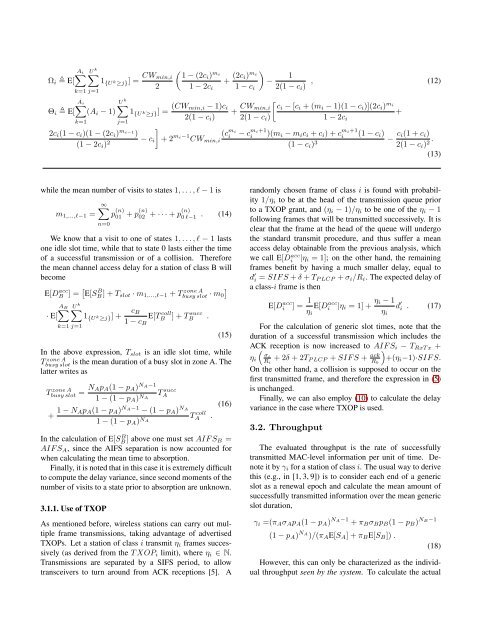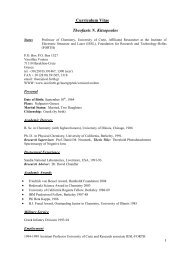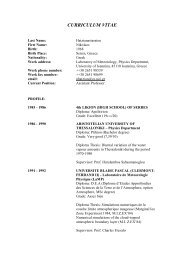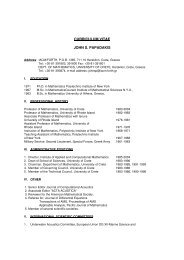802.11e EDCA Protocol Parameterization: A Modeling and ...
802.11e EDCA Protocol Parameterization: A Modeling and ...
802.11e EDCA Protocol Parameterization: A Modeling and ...
You also want an ePaper? Increase the reach of your titles
YUMPU automatically turns print PDFs into web optimized ePapers that Google loves.
∑A iΩ i E[∑U kk=1 j=1k=11 {Uk ≥j}] = CW min,i2∑A i∑Θ i E[ (A i − 1) 1 {Uk ≥j}] = (CW min,i − 1)c i2(1 − c i )U kj=1]2c i (1 − c i )(1 − (2c i ) mi−1 )(1 − 2c i ) 2 − c i + 2 mi−1 (c miiCW min,i( 1 − (2ci ) mi+ (2c )i) mi 1−1 − 2c i 1 − c i 2(1 − c i ) , (12)+ CW [min,i ci − [c i + (m i − 1)(1 − c i )](2c i ) mi+2(1 − c i ) 1 − 2c i− c mi+1i)(m i − m i c i + c i ) + c mi+1i (1 − c i )(1 − c i ) 3 − c i(1 + c i )2(1 − c i ) 2 .(13)while the mean number of visits to states 1,...,l − 1 ism 1,...,l−1 =∞∑n=0p (n)01 + p(n) 02 + · · · + p(n) 0 l−1 . (14)We know that a visit to one of states 1,...,l − 1 lastsone idle slot time, while that to state 0 lasts either the timeof a successful transmission or of a collision. Thereforethe mean channel access delay for a station of class B willbecomeE[DB acc ] = [ E[SB] B + T slot · m 1,...,l−1 + Tbusy zone slot A ]· m 0∑A B∑· E[ 1 {U ≥j}] + c BE[T k Bcoll1 − c BU kk=1 j=1] + T succB .(15)In the above expression, T slot is an idle slot time, whileTbusy zone slot A is the mean duration of a busy slot in zone A. Thelatter writes asTbusy zone slot A = N Ap A (1 − p A ) NA−1T succ1 − (1 − p A ) NA A+ 1 − N Ap A (1 − p A ) NA−1 − (1 − p A ) NA1 − (1 − p A ) NA T collA .(16)In the calculation of E[S B B ] above one must set AIFS B =AIFS A , since the AIFS separation is now accounted forwhen calculating the mean time to absorption.Finally, it is noted that in this case it is extremely difficultto compute the delay variance, since second moments of thenumber of visits to a state prior to absorption are unknown.3.1.1. Use of TXOPAs mentioned before, wireless stations can carry out multipleframe transmissions, taking advantage of advertisedTXOPs. Let a station of class i transmit η i frames successively(as derived from the TXOP i limit), where η i ∈ N.Transmissions are separated by a SIFS period, to allowtransceivers to turn around from ACK receptions [5]. Ar<strong>and</strong>omly chosen frame of class i is found with probability1/η i to be at the head of the transmission queue priorto a TXOP grant, <strong>and</strong> (η i − 1)/η i to be one of the η i − 1following frames that will be transmitted successively. It isclear that the frame at the head of the queue will undergothe st<strong>and</strong>ard transmit procedure, <strong>and</strong> thus suffer a meanaccess delay obtainable from the previous analysis, which|η i = 1]; on the other h<strong>and</strong>, the remainingframes benefit by having a much smaller delay, equal tod ′ i = SIFS + δ + T PLCP + σ i /R i . The expected delay ofa class-i frame is thenwe call E[D acciE[Diacc ] = 1 E[Di acc |η i = 1] + η i − 1d ′ i . (17)η i η iFor the calculation of generic slot times, note that theduration of a successful transmission which includes theACK ( reception is now increased to AIFS i − T RxTx +ση i i R i+ 2δ + 2T PLCP + SIFS + ackR b)+(η i −1)·SIFS.On the other h<strong>and</strong>, a collision is supposed to occur on thefirst transmitted frame, <strong>and</strong> therefore the expression in (5)is unchanged.Finally, we can also employ (10) to calculate the delayvariance in the case where TXOP is used.3.2. ThroughputThe evaluated throughput is the rate of successfullytransmitted MAC-level information per unit of time. Denoteit by γ i for a station of class i. The usual way to derivethis (e.g., in [1, 3, 9]) is to consider each end of a genericslot as a renewal epoch <strong>and</strong> calculate the mean amount ofsuccessfully transmitted information over the mean genericslot duration,γ i =(π A σ A p A (1 − p A ) NA−1 + π B σ B p B (1 − p B ) NB−1(1 − p A ) NA )/(π A E[S A ] + π B E[S B ]) .(18)However, this can only be characterized as the individualthroughput seen by the system. To calculate the actual





